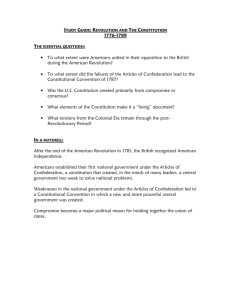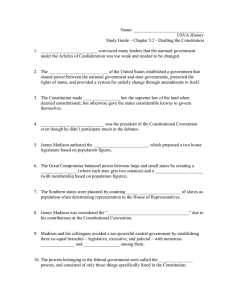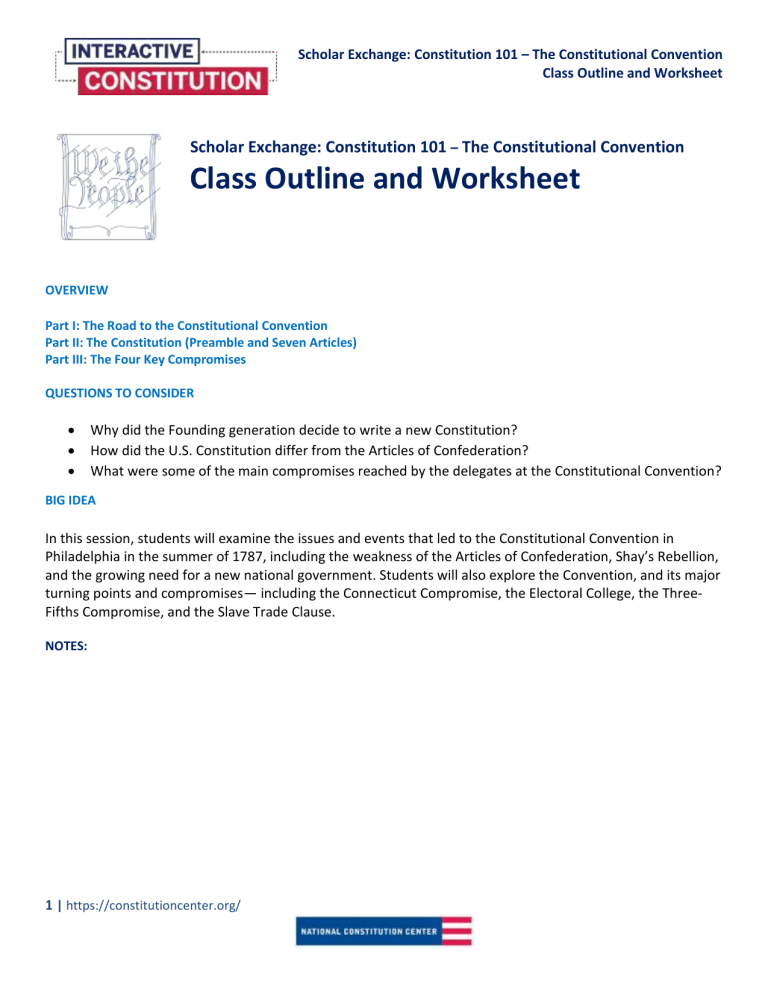
Scholar Exchange: Constitution 101 – The Constitutional Convention Class Outline and Worksheet Scholar Exchange: Constitution 101 – The Constitutional Convention Class Outline and Worksheet OVERVIEW Part I: The Road to the Constitutional Convention Part II: The Constitution (Preamble and Seven Articles) Part III: The Four Key Compromises QUESTIONS TO CONSIDER Why did the Founding generation decide to write a new Constitution? How did the U.S. Constitution differ from the Articles of Confederation? What were some of the main compromises reached by the delegates at the Constitutional Convention? BIG IDEA In this session, students will examine the issues and events that led to the Constitutional Convention in Philadelphia in the summer of 1787, including the weakness of the Articles of Confederation, Shay’s Rebellion, and the growing need for a new national government. Students will also explore the Convention, and its major turning points and compromises— including the Connecticut Compromise, the Electoral College, the ThreeFifths Compromise, and the Slave Trade Clause. NOTES: 1 | https://constitutioncenter.org/ Scholar Exchange: Constitution 101 – The Constitutional Convention Class Outline and Worksheet I. THE ARTICLES OF CONFEDERATION: AN INSUFFICIENT FIRST ATTEMPT Describe America’s first national government under the Articles of Confederation. What were FOUR of the major issues that caused America’s political leaders to meet at the Constitutional Convention? 1. A unanimous vote between all the states was needed to amend the Articles. This was extremely difficult, almost impossible, for the states to achieve, so necessary changes could not pass. 2. 3. 4. II. SHAYS’ REBELLION: A CONSTITUTIONAL WAKE-UP CALL What were the circumstances that led up to Shays’ Rebellion, and who was involved in the conflict? What did America’s political leaders realize after this uprising? 2 | https://constitutioncenter.org/ Scholar Exchange: Constitution 101 – The Constitutional Convention Class Outline and Worksheet III. SETTING THE SCENE: THE CONVENTION IN PHILADELPHIA The Convention delegates met and debated in secret ---- what was the reason for this secrecy? Find out the start and end dates of the Convention and use them to fill in the table. The Constitutional Convention started on: The Constitutional Convention ended on: IV. THE STRUCTURAL CONSTITUTION: A PREAMBLE AND SEVEN ARTICLES What are the first three words of the Preamble, and what do they represent? The Preamble beings with ________________ ________________ _______________ How would you briefly describe each of the seven articles of the Constitution? Article I: Article II: Article III: Article IV: Addresses the state-citizen relationship, admission of new states, governing of federal territories, and the Fugitive Slave Clause. Article V: Article VI: Article VII: 3 | https://constitutioncenter.org/ Scholar Exchange: Constitution 101 – The Constitutional Convention Class Outline and Worksheet V. KEY COMPROMISE 1: DEBATES OVER REPRESENTATION The longest article of the Constitution resulted from the long debate over Congress. Describe TWO opposing plans proposed in the debate. What final compromise gave us our present solution, and how is Congress structured in it? The ____________________ Plan Proposed By: The ____________________ Plan Proposed By: The ________________ Compromise Proposed By: Description: Description: Description: VI. KEY COMPROMISE 2: HOW DO WE ELECT A PRESIDENT? Describe TWO of the opposing plans proposed in this debate and the reasoning behind each. Which final compromise gave the solution to this debate, and how is the presidential election structured in it? Proposal 1: Proposal 2: Compromise: ___________________ Proposed By: Description: Description: Description: 4 | https://constitutioncenter.org/ Scholar Exchange: Constitution 101 – The Constitutional Convention Class Outline and Worksheet VII. KEY COMPROMISE 3: WILL ENSLAVED PEOPLE COUNT IN STATE REPRESENTATION? What motivations were behind each side of the argument surrounding representation of enslaved people? Which final compromise gave the solution to this debate, and what were its long-term political effects? Group 1: Against Representation for Enslaved People Group 2: In Favor of Representation for Enslaved People The ________________ Compromise Proposed By: Motivations: Motivations: Description: VIII. KEY COMPROMISE 4: DOES CONGRESS HAVE THE POWER TO ABOLISH THE SLAVE TRADE? What does the Slave Trade Clause say about abolishing the international slave trade? Why doesn’t slavery “die off” on its own, though many delegates believed it would? 5 | https://constitutioncenter.org/
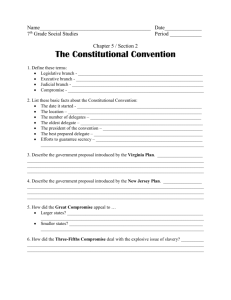


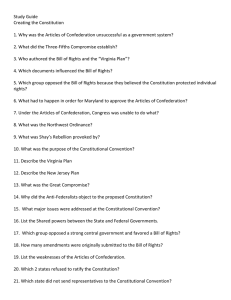
![Quiz About [Your topic]](http://s2.studylib.net/store/data/010236459_1-eafee5cbeabd58360217625fb978acb5-300x300.png)
